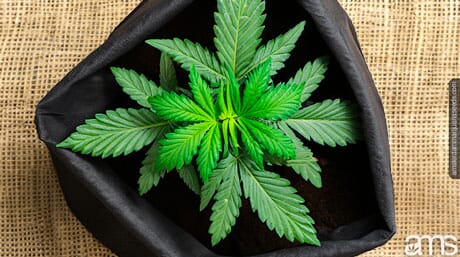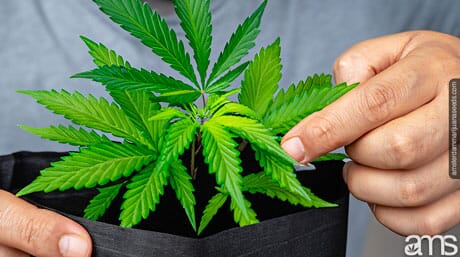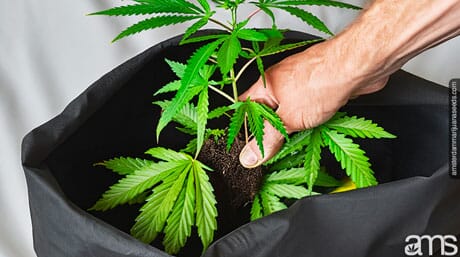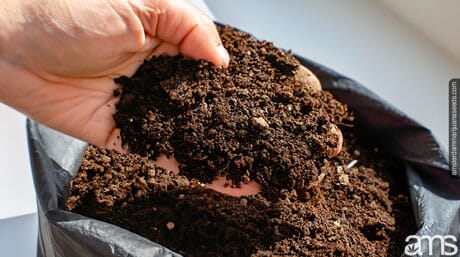Introduction
Welcome to the ultimate guide on using grow bags for growing cannabis. Whether you’re a seasoned gardener or a cannabis enthusiast looking to cultivate your favorite strain, grow bags offer a versatile and efficient way to nurture healthy cannabis plants. In this article, we’ll answer the most frequently asked questions about grow bags for cannabis cultivation and provide valuable insights into their advantages, disadvantages, and optimal usage. Let’s dive in!
Are Grow Bags Better Than Buckets?
Grow bags have become increasingly popular among cannabis growers due to their numerous benefits. Unlike traditional buckets, grow bags offer superior aeration, root pruning, and drainage, creating a healthier environment for cannabis plants. The porous fabric of grow bags allows excess water to escape, preventing overwatering and root rot, which is a common issue with buckets. Additionally, grow bags are space-efficient and easy to store, making them a practical choice for indoor and outdoor cultivation.

The Pros and Cons of Growing Bags
Like any gardening method, grow bags have their advantages and disadvantages. Let’s explore them in detail:
Pros:
- Aeration: Grow bags promote better air circulation, preventing root circling and promoting healthier root systems.
- Drainage: The breathable fabric ensures proper drainage, reducing the risk of overwatering.
- Prevents Overheating: Grow bags release excess heat, keeping the root zone cooler during hot weather.
- Space-Efficient: They can be easily arranged in tight spaces, maximizing planting area.
- Reusable: Quality grow bags can be washed and reused for multiple growing seasons.
Cons:
- Susceptibility to Drying: Grow bags may dry out more quickly than containers, necessitating more frequent watering in certain environments.
- Durability: Lower-quality grow bags may tear or degrade over time.
- Stability: The soft-sided nature of grow bags can be less stable than rigid containers.
What Size Grow Bag is Best for Indoor Cannabis?
The ideal size of a grow bag for indoor cannabis depends on the space available and the desired plant size. For most indoor growers, a 5-gallon grow bag is a popular choice. This size provides ample space for the roots to spread and promotes healthy growth without taking up excessive room. However, if you have limited space, consider using 3-gallon grow bags for smaller cannabis plants.

Do Bigger Grow Bags Mean Bigger Buds?
While the size of grow bags can influence plant growth, it’s essential to understand that bigger bags alone won’t guarantee bigger buds. The health and yield of cannabis plants depend on various factors, including light, nutrients, genetics, and environmental conditions. Adequate lighting, proper nutrition, and careful cultivation techniques play a more significant role in bud development.
Is Grow Bags Better for Roots?
Yes, grow bags are generally better for root health compared to traditional containers. The fabric material of grow bags allows air to reach the root zone, encouraging air pruning. When roots reach the fabric’s edge, they encounter air, causing the tips to desiccate and branching to occur. This process prevents root circling, promotes a more extensive root system, and enhances nutrient uptake.

The Disadvantages of Using Grow Bags
While grow bags offer several advantages, it’s crucial to be aware of potential drawbacks:
- Frequent Watering: Grow bags may require more frequent watering compared to conventional containers due to their superior drainage and aeration.
- Durability: Lower-quality grow bags may tear or degrade over time, especially if reused for multiple seasons.
- Stability: Soft-sided grow bags may be less stable than rigid containers, requiring additional support in windy conditions.
Are Grow Bags Better Than Compost?
Grow bags and compost serve different purposes in cannabis cultivation. Grow bags are containers made of breathable fabric that promote healthier root systems through improved aeration and drainage. Compost, on the other hand, is a nutrient-rich organic material that enhances soil quality and fertility. While grow bags provide a conducive environment for roots, compost enriches the soil and provides essential nutrients for plant growth. When used together, grow bags and compost can complement each other, resulting in optimal cannabis growth.
Should I Use Potting Soil in Grow Bags?
Using high-quality potting soil is recommended when cultivating cannabis in grow bags. Look for well-balanced potting mixes that include a blend of peat moss, vermiculite, and perlite. These components provide essential nutrients, promote proper drainage, and offer the right level of aeration for healthy root development. Avoid using garden soil in grow bags, as it may lack the necessary properties and lead to poor plant growth.

Are Grow Bags Better Than Plastic?
Grow bags and plastic containers cater to different gardening needs. While plastic containers are durable and stable, they lack the superior drainage and aeration of grow bags. The non-porous nature of plastic can lead to overwatering and root issues. Grow bags, with their breathable fabric, offer improved air circulation and prevent waterlogged roots. However, both options have their benefits and can be used successfully for cannabis cultivation based on personal preferences and growing conditions.
How Long Can a Grow Bag Last?
The lifespan of a grow bag varies depending on its quality and usage. High-quality grow bags made from sturdy fabric can last for several growing seasons if properly cared for and stored during the off-season. Regularly clean the grow bags after each use, allow them to dry completely, and store them in a cool, dry place to extend their lifespan.
Should I Put Holes in My Grow Bag?
Grow bags are designed with pre-made drainage holes to allow excess water to escape, preventing overwatering. However, in certain cases, additional holes may be necessary to ensure proper drainage, especially if you notice water pooling at the bottom of the bag. Use a sharp object to make small drainage holes at the bottom, ensuring they do not compromise the structural integrity of the bag.

Should I Put Rocks in the Bottom of My Grow Bag?
Adding rocks or stones at the bottom of grow bags is unnecessary and may lead to drainage issues. The practice was once believed to improve drainage, but it can create a false water table, leading to waterlogged soil at the root level. For optimal results, rely on the natural drainage provided by the grow bag’s fabric and ensure the bag has adequate drainage holes.
Do Grow Bags Get Too Hot?
Grow bags are designed to release excess heat, preventing the root zone from getting too hot. The breathable fabric allows air to circulate around the root system, maintaining a more stable temperature. However, in extremely hot climates, grow bags can still get warm. To mitigate this, place the grow bags in a shaded area or use mulch to insulate the root zone and retain moisture.
Do Grow Bags Need Perlite?
While perlite can enhance the drainage and aeration of potting soil, it is not essential for grow bags. Grow bags already provide excellent aeration and drainage due to their fabric material. However, if you prefer a looser soil mix, you can add perlite to your potting soil before filling the grow bags.
When Should You Stop Using a Grow Bag?
Grow bags are reusable and can last for multiple growing seasons. However, over time, the fabric may become worn or damaged. Consider replacing the grow bags if you notice significant tears or degradation that may compromise the root zone’s health. Regularly inspect the grow bags after each growing season to assess their condition.

What Can I Use Instead of Grow Bags?
If grow bags are not available, several alternative containers can be used for cannabis cultivation, including:
- Plastic Nursery Pots: Similar to grow bags but made of plastic, these pots provide good drainage.
- Fabric Pots: Fabric containers with properties similar to grow bags, promoting aeration and root pruning.
- Five-Gallon Buckets: While not as efficient as grow bags, buckets can still be used for cannabis cultivation with proper drainage and aeration.
Can You Use Grow Bags Twice?
Yes, grow bags can be reused for multiple growing seasons with proper care and maintenance. After each growing season, clean the grow bags thoroughly, allow them to dry completely, and store them in a cool, dry location. Inspect the grow bags for any signs of damage or wear before using them again.
What is the Best Size Grow Bag?
The best size grow bag for cannabis depends on several factors, including the available space, plant size, and growing environment. For most indoor growers, 5-gallon grow bags are a popular choice, offering ample room for root growth without taking up excessive space. Outdoor growers may opt for larger sizes, such as 10-gallon grow bags, for larger plants or increased root space.
Do Grow Bags Need Trays?
Grow bags typically do not require trays, as their superior drainage prevents water from pooling at the bottom. However, if you want to protect the surface beneath the grow bags or prefer a neater appearance, you can use trays or saucers.
How Many Plants Can You Put in a Grow Bag?
The number of plants per grow bag depends on the bag’s size and the intended plant size. In a 5-gallon grow bag, one healthy cannabis plant is typically recommended. For smaller cannabis plants or those with shorter growth periods, you may consider growing two plants in a 5-gallon grow bag. However, overcrowding should be avoided, as it can lead to competition for nutrients and space.
Can I Bottom Water in a Grow Bag?
While bottom watering can be done in certain situations, it is not the most efficient method for grow bags. Due to the breathable fabric, water may escape through the bottom, leading to uneven watering and potential overwatering. Instead, opt for top watering, allowing water to evenly disperse throughout the growing medium and promote even root growth.
Conclusion
Grow bags offer a fantastic option for cultivating healthy and thriving cannabis plants. With their excellent drainage, aeration, and root-friendly environment, they can help you achieve successful cannabis cultivation both indoors and outdoors. Consider the advantages and disadvantages of grow bags, select the appropriate size for your needs, and follow best practices to grow vigorous cannabis plants in these versatile containers. Happy gardening!
Frequently Asked Questions
Yes, grow bags are suitable for both indoor and outdoor cannabis cultivation.
Watering frequency varies depending on environmental conditions. Check the soil moisture regularly and water when the top inch feels dry.
Yes, DIY grow bags can be made from breathable fabric and are a cost-effective option.
Ensure proper spacing between plants and provide adequate support for taller cannabis varieties.
Regularly monitor water and nutrient levels, prune as needed, and protect the plants from pests and diseases.
Rinse the grow bags with water, scrub away any debris, and let them air dry before storing.
Disclaimer: This content is meant for educational purposes only. It has been compiled with research from external sources. it is not meant to substitute any medical or legal advice. Please see your local laws for the legality of cannabis use.
- SEO Powered Content & PR Distribution. Get Amplified Today.
- PlatoData.Network Vertical Generative Ai. Empower Yourself. Access Here.
- PlatoAiStream. Web3 Intelligence. Knowledge Amplified. Access Here.
- PlatoESG. Automotive / EVs, Carbon, CleanTech, Energy, Environment, Solar, Waste Management. Access Here.
- BlockOffsets. Modernizing Environmental Offset Ownership. Access Here.
- Source: https://amsterdammarijuanaseeds.com/blog/grow-bags-for-growing-cannabis-the-ultimate-guide



